warning INFINITI Q70 HYBRID 2014 Dismantling Guide
[x] Cancel search | Manufacturer: INFINITI, Model Year: 2014, Model line: Q70 HYBRID, Model: INFINITI Q70 HYBRID 2014Pages: 51, PDF Size: 3.65 MB
Page 2 of 51
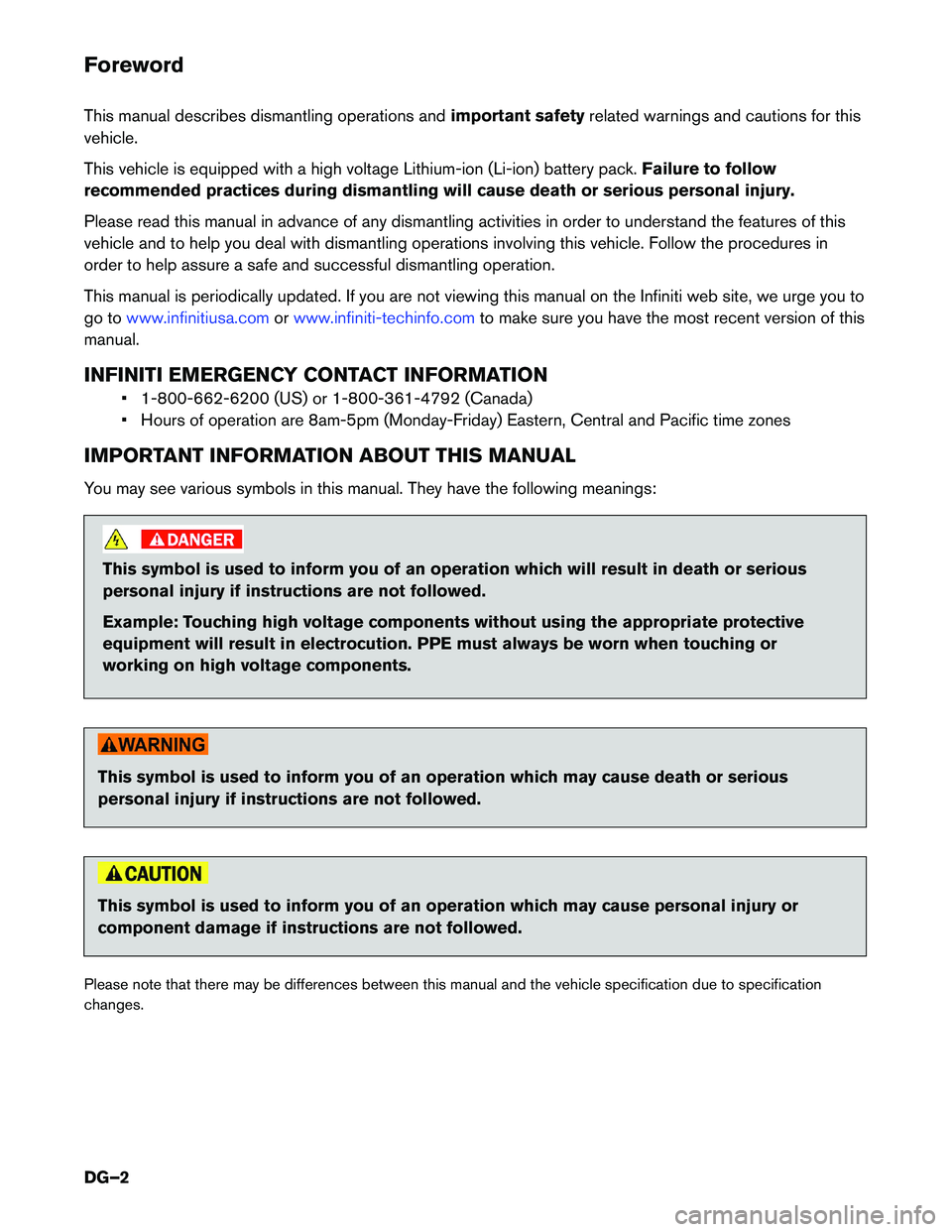
Foreword
This
manual describes dismantling operations and important safetyrelated warnings and cautions for this
vehicle.
This vehicle is equipped with a high voltage Lithium-ion (Li-ion) battery pack. Failure to follow
recommended practices during dismantling will cause death or serious personal injury.
Please read this manual in advance of any dismantling activities in order to understand the features of this
vehicle and to help you deal with dismantling operations involving this vehicle. Follow the procedures in
order to help assure a safe and successful dismantling operation.
This manual is periodically updated. If you are not viewing this manual on the Infiniti web site, we urge you to
go to www.infinitiusa.com orwww.infiniti-techinfo.com to make sure you have the most recent version of this
manual.
INFINITI
EMERGENCY CONTACT INFORMATION
• 1-800-662-6200 (US) or 1-800-361-4792 (Canada)
• Hours of operation are 8am-5pm (Monday-Friday) Eastern, Central and Pacific time zones
IMPORTANT INFORMATION ABOUT THIS MANUAL
You may see various symbols in this manual. They have the following meanings: This symbol is used to inform you of an operation which will result in death or serious
personal
injury if instructions are not followed.
Example: Touching high voltage components without using the appropriate protective
equipment will result in electrocution. PPE must always be worn when touching or
working on high voltage components. This symbol is used to inform you of an operation which may cause death or serious
personal
injury if instructions are not followed. This symbol is used to inform you of an operation which may cause personal injury or
component
damage if instructions are not followed.
Please note that there may be differences between this manual and the vehicle specification due to specification
changes.
DG–2
Page 3 of 51
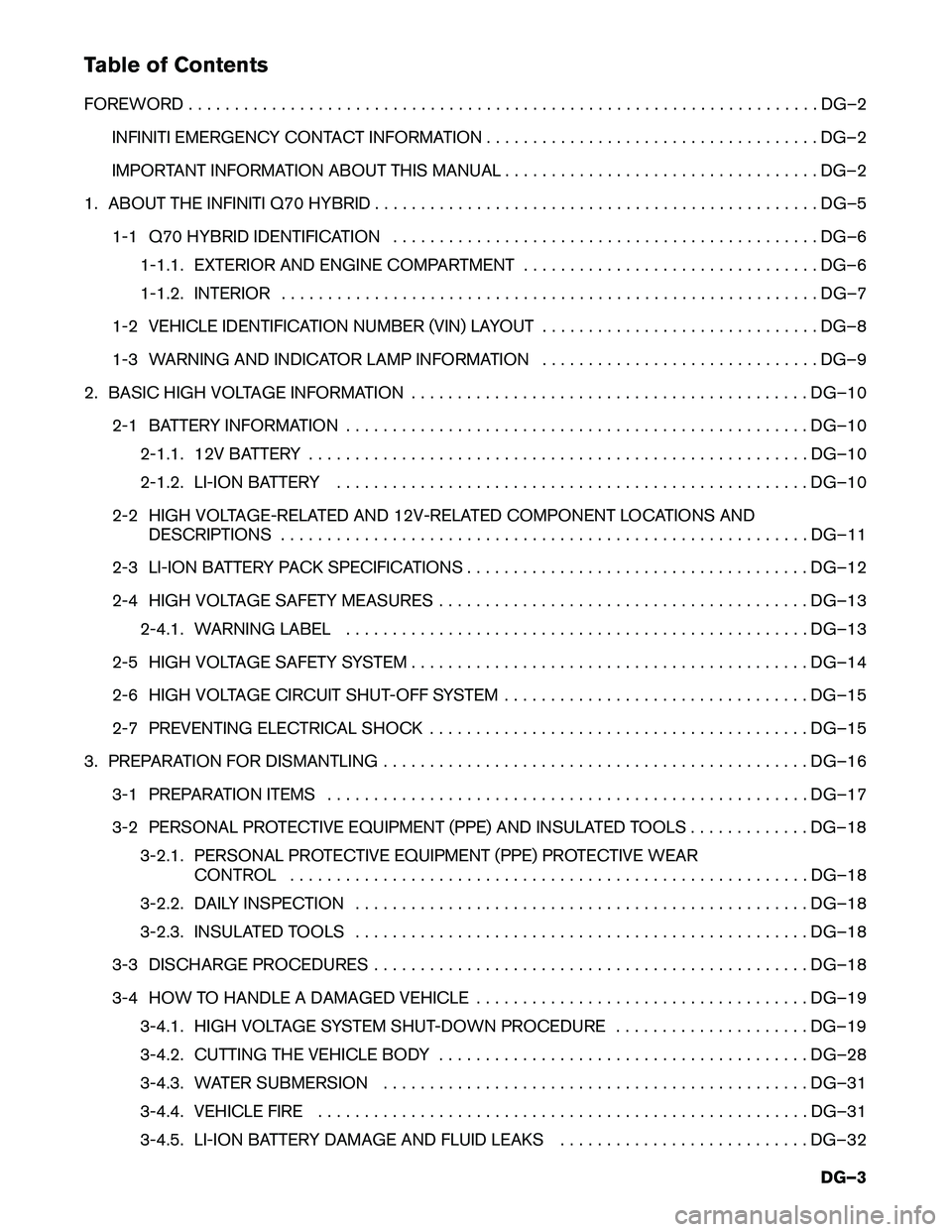
Table of Contents
FOREWORD
. . . . . . . . . . . . . . . . . . . . . . . . . . . . . . . . . . . . . . . . . . . . . . . . . . . . . . . . . . . . . . . . . . . . DG–2
INFINITI EMERGENCY CONTACT INFORMATION . . . . . . . . . . . . . . . . . . . . . . . . . . . . . . . . . . . . DG–2
IMPORTANT INFORMATION ABOUT THIS MANUAL . . . . . . . . . . . . . . . . . . . . . . . . . . . . . . . . . . DG–2
1. ABOUT THE INFINITI Q70 HYBRID . . . . . . . . . . . . . . . . . . . . . . . . . . . . . . . . . . . . . . . . . . . . . . . . DG–5 1-1 Q70 HYBRID IDENTIFICATION . . . . . . . . . . . . . . . . . . . . . . . . . . . . . . . . . . . . . . . . . . . . . . DG–6 1-1.1. EXTERIOR AND ENGINE COMPARTMENT . . . . . . . . . . . . . . . . . . . . . . . . . . . . . . . . DG–6
1-1.2. INTERIOR . . . . . . . . . . . . . . . . . . . . . . . . . . . . . . . . . . . . . . . . . . . . . . . . . . . . . . . . . . DG–7
1-2 VEHICLE IDENTIFICATION NUMBER (VIN) LAYOUT . . . . . . . . . . . . . . . . . . . . . . . . . . . . . . DG–8
1-3 WARNING AND INDICATOR LAMP INFORMATION . . . . . . . . . . . . . . . . . . . . . . . . . . . . . . DG–9
2. BASIC HIGH VOLTAGE INFORMATION . . . . . . . . . . . . . . . . . . . . . . . . . . . . . . . . . . . . . . . . . . . DG–10
2-1 BATTERY INFORMATION . . . . . . . . . . . . . . . . . . . . . . . . . . . . . . . . . . . . . . . . . . . . . . . . . . DG–10 2-1.1. 12V BATTERY . . . . . . . . . . . . . . . . . . . . . . . . . . . . . . . . . . . . . . . . . . . . . . . . . . . . . . DG–10
2-1.2. LI-ION BATTERY . . . . . . . . . . . . . . . . . . . . . . . . . . . . . . . . . . . . . . . . . . . . . . . . . . . DG–10
2-2 HIGH VOLTAGE-RELATED AND 12V-RELATED COMPONENT LOCATIONS AND DESCRIPTIONS . . . . . . . . . . . . . . . . . . . . . . . . . . . . . . . . . . . . . . . . . . . . . . . . . . . . . . . . . DG–11
2-3 LI-ION BATTERY PACK SPECIFICATIONS . . . . . . . . . . . . . . . . . . . . . . . . . . . . . . . . . . . . . DG–12
2-4 HIGH VOLTAGE SAFETY MEASURES . . . . . . . . . . . . . . . . . . . . . . . . . . . . . . . . . . . . . . . . DG–13 2-4.1. WARNING LABEL . . . . . . . . . . . . . . . . . . . . . . . . . . . . . . . . . . . . . . . . . . . . . . . . . . DG–13
2-5 HIGH VOLTAGE SAFETY SYSTEM . . . . . . . . . . . . . . . . . . . . . . . . . . . . . . . . . . . . . . . . . . . DG–14
2-6 HIGH VOLTAGE CIRCUIT SHUT-OFF SYSTEM . . . . . . . . . . . . . . . . . . . . . . . . . . . . . . . . . DG–15
2-7 PREVENTING ELECTRICAL SHOCK . . . . . . . . . . . . . . . . . . . . . . . . . . . . . . . . . . . . . . . . . DG–15
3. PREPARATION FOR DISMANTLING . . . . . . . . . . . . . . . . . . . . . . . . . . . . . . . . . . . . . . . . . . . . . . DG–16 3-1 PREPARATION ITEMS . . . . . . . . . . . . . . . . . . . . . . . . . . . . . . . . . . . . . . . . . . . . . . . . . . . . DG–17
3-2 PERSONAL PROTECTIVE EQUIPMENT (PPE) AND INSULATED TOOLS . . . . . . . . . . . . . DG–183-2.1. PERSONAL PROTECTIVE EQUIPMENT (PPE) PROTECTIVE WEAR CONTROL . . . . . . . . . . . . . . . . . . . . . . . . . . . . . . . . . . . . . . . . . . . . . . . . . . . . . . . . DG–18
3-2.2. DAILY INSPECTION . . . . . . . . . . . . . . . . . . . . . . . . . . . . . . . . . . . . . . . . . . . . . . . . . DG–18
3-2.3. INSULATED TOOLS . . . . . . . . . . . . . . . . . . . . . . . . . . . . . . . . . . . . . . . . . . . . . . . . . DG–18
3-3 DISCHARGE PROCEDURES . . . . . . . . . . . . . . . . . . . . . . . . . . . . . . . . . . . . . . . . . . . . . . . DG–18
3-4 HOW TO HANDLE A DAMAGED VEHICLE . . . . . . . . . . . . . . . . . . . . . . . . . . . . . . . . . . . . DG–19 3-4.1. HIGH VOLTAGE SYSTEM SHUT-DOWN PROCEDURE . . . . . . . . . . . . . . . . . . . . . DG–19
3-4.2. CUTTING THE VEHICLE BODY . . . . . . . . . . . . . . . . . . . . . . . . . . . . . . . . . . . . . . . . DG–28
3-4.3. WATER SUBMERSION . . . . . . . . . . . . . . . . . . . . . . . . . . . . . . . . . . . . . . . . . . . . . . DG–31
3-4.4. VEHICLE FIRE . . . . . . . . . . . . . . . . . . . . . . . . . . . . . . . . . . . . . . . . . . . . . . . . . . . . . DG–31
3-4.5. LI-ION BATTERY DAMAGE AND FLUID LEAKS . . . . . . . . . . . . . . . . . . . . . . . . . . . DG–32
DG–3
Page 9 of 51
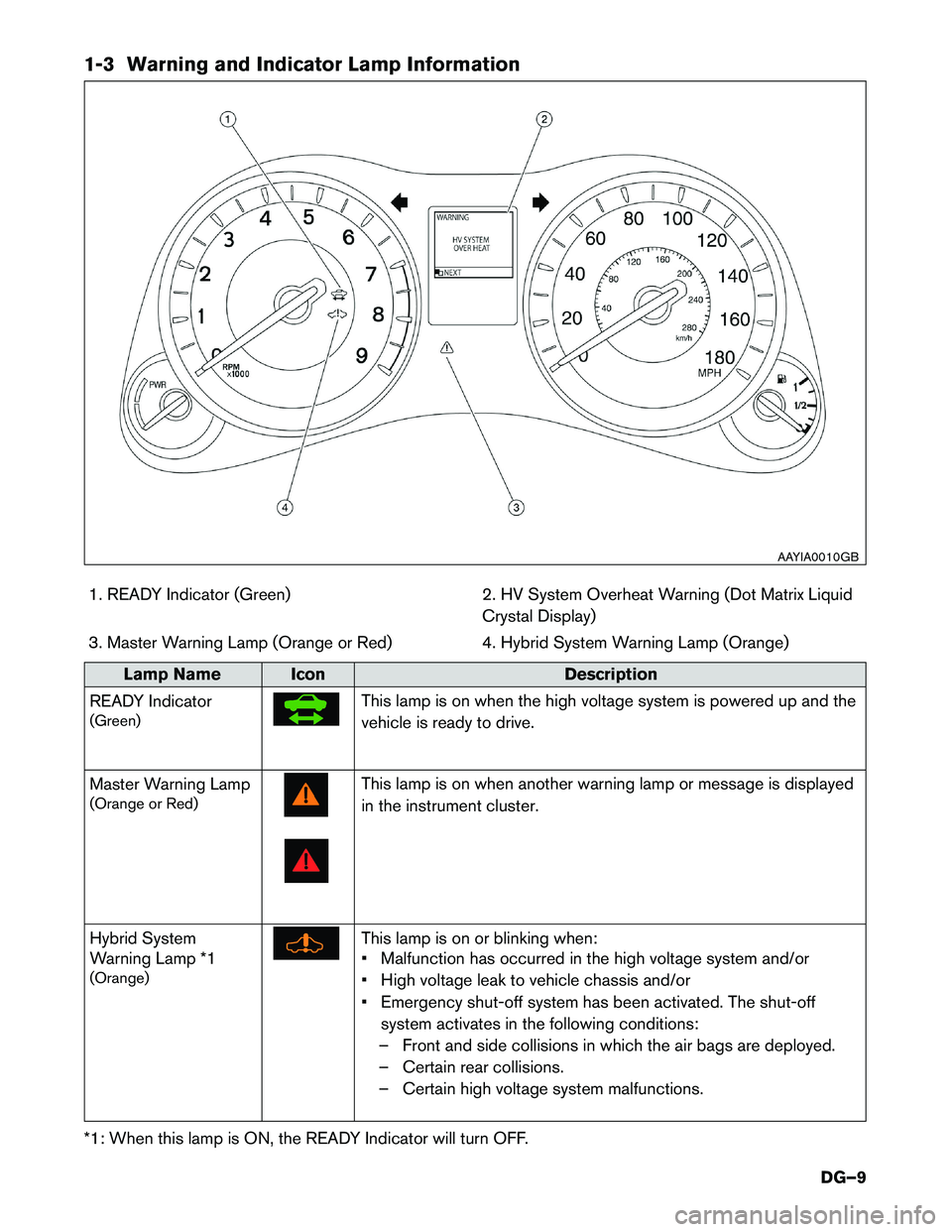
1-3 Warning and Indicator Lamp Information
1. READY Indicator (Green) 2. HV System Overheat Warning (Dot Matrix Liquid
Crystal Display)
3. Master Warning Lamp (Orange or Red) 4. Hybrid System Warning Lamp (Orange)Lamp Name Icon
Description
READ
Y Indicator
(Green) This lamp is on when the high voltage system is powered up and the
vehicle
is ready to drive.
Master Warning Lamp
(Orange or Red) This lamp is on when another warning lamp or message is displayed
in
the instrument cluster.
Hybrid System
Warning Lamp *1
(Orange) This lamp is on or blinking when:
•
Malfunction has occurred in the high voltage system and/or
• High voltage leak to vehicle chassis and/or
• Emergency shut-off system has been activated. The shut-off system activates in the following conditions:
– Front and side collisions in which the air bags are deployed.
– Certain rear collisions.
– Certain high voltage system malfunctions.
*1: When this lamp is ON, the READY Indicator will turn OFF. AAYIA0010GB
DG–9
Page 13 of 51
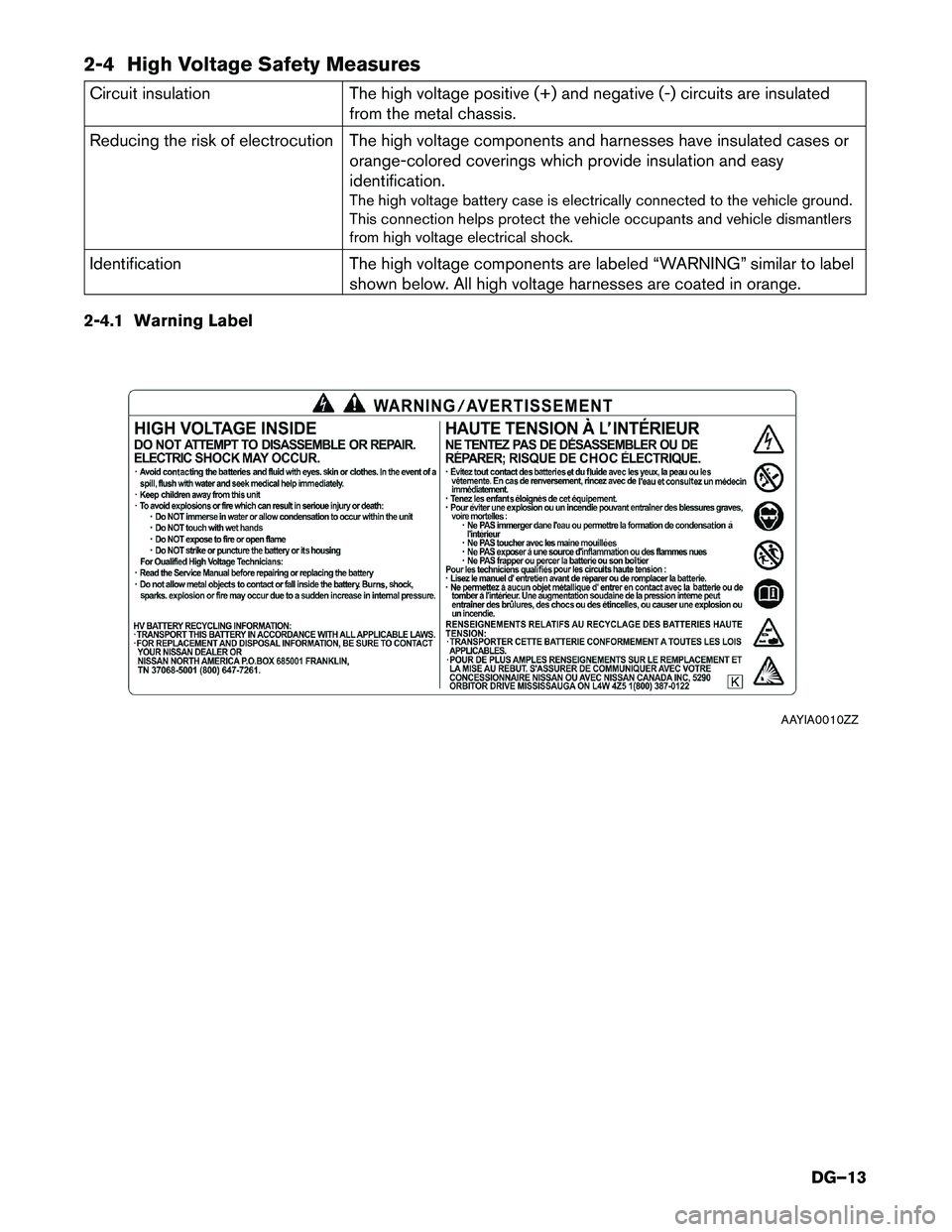
2-4 High Voltage Safety Measures
Circuit insulation
The high voltage positive (+) and negative (-) circuits are insulated
from the metal chassis.
Reducing the risk of electrocution The high voltage components and harnesses have insulated cases or orange-colored coverings which provide insulation and easy
identification.
The high voltage battery case is electrically connected to the vehicle ground.
This connection helps protect the vehicle occupants and vehicle dismantlers
from high voltage electrical shock.
Identification The high voltage components are labeled “WARNING” similar to label
shown below. All high voltage harnesses are coated in orange.
2-4.1 Warning Label AAYIA0010ZZ
DG–13
Page 14 of 51
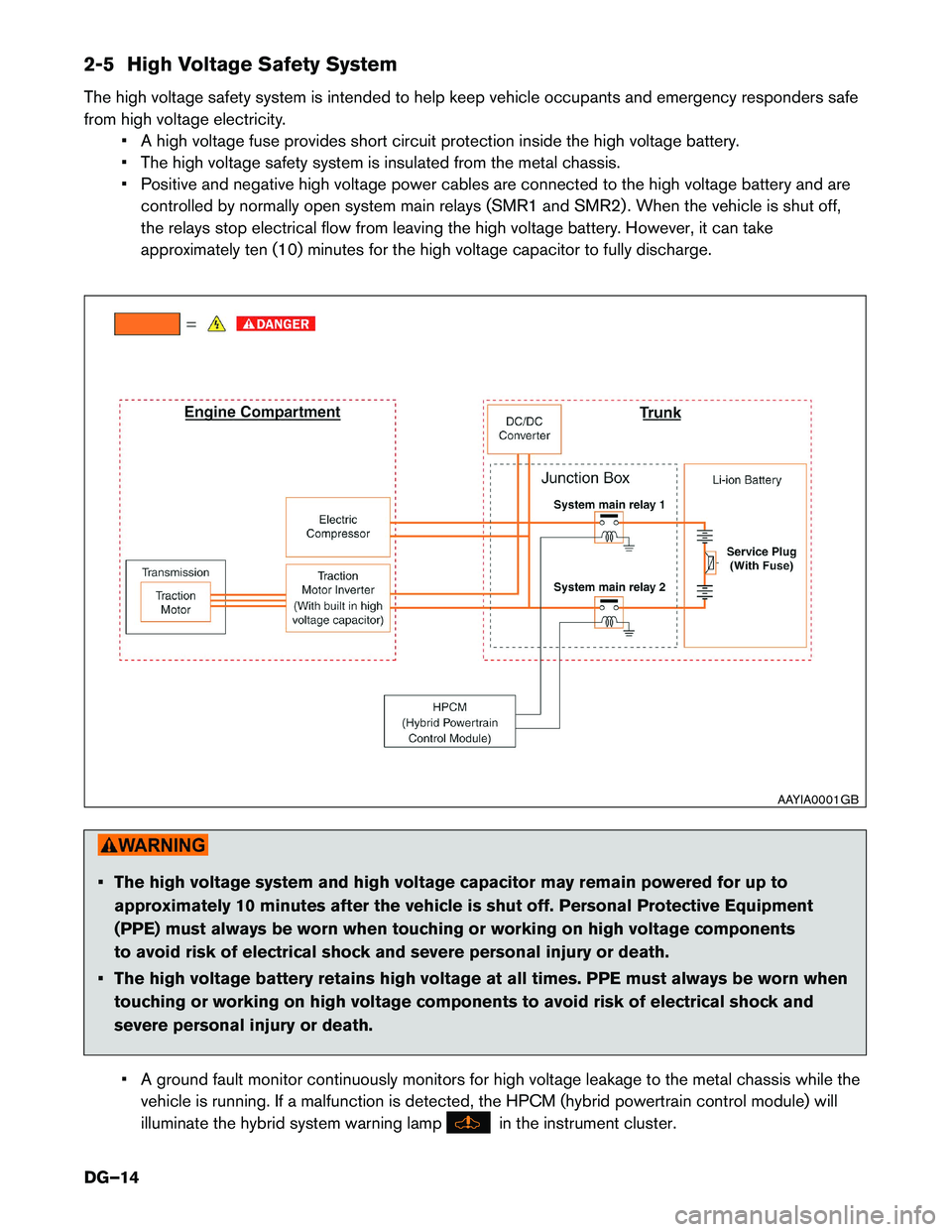
2-5 High Voltage Safety System
The
high voltage safety system is intended to help keep vehicle occupants and emergency responders safe
from high voltage electricity. • A high voltage fuse provides short circuit protection inside the high voltage battery.
• The high voltage safety system is insulated from the metal chassis.
• Positive and negative high voltage power cables are connected to the high voltage battery and arecontrolled by normally open system main relays (SMR1 and SMR2) . When the vehicle is shut off,
the relays stop electrical flow from leaving the high voltage battery. However, it can take
approximately ten (10) minutes for the high voltage capacitor to fully discharge. • The high voltage system and high voltage capacitor may remain powered for up to
approximately
10 minutes after the vehicle is shut off. Personal Protective Equipment
(PPE) must always be worn when touching or working on high voltage components
to avoid risk of electrical shock and severe personal injury or death.
• The high voltage battery retains high voltage at all times. PPE must always be worn when touching or working on high voltage components to avoid risk of electrical shock and
severe personal injury or death.
• A ground fault monitor continuously monitors for high voltage leakage to the metal chassis while the vehicle is running. If a malfunction is detected, the HPCM (hybrid powertrain control module) will
illuminate the hybrid system warning lamp in the instrument cluster. AAYIA0001GB
DG–14
Page 19 of 51

9. Release the parking brake.
10. Turn ON electric devices such as headlamps, A/C (set to the coldest temperature) and rear
window defogger to discharge the high voltage battery. Allow approximately 15 minutes to
discharge. Discharge is complete when the READY indicator (B) (green) turns OFF and the
hybrid
system warning indicator (C) (orange) turns ON.
11. Press the ignition switch (A) to turn the system OFF.
Please contact following number if the vehicle could not be discharged. • 1-800-662-6200 (US) or 1-800-361-4792 (Canada)
• Hours of operation are 8am-5pm (Monday-Friday) Eastern, Central and Pacific time zones.
3-4 How to Handle a Damaged Vehicle
3-4.1 High Voltage System Shut-Down Procedure
Any of the following procedures can shut down the high voltage system. The dismantling operation can only
begin after shutting down the high voltage system. If the vehicle is heavily damaged, for example the Li-ion
battery is deformed, broken or cracked, appropriate PPE must always be used and the Li-ion battery and
high voltage components must not be touched. • Failure to properly shut down the high voltage system before the dismantling
procedures
are performed will result in serious injury or death from electrical shock. To
prevent serious injury or death, NEVER touch high voltage harnesses or components
without always wearing appropriate Personal Protective Equipment (PPE) . PPE
must always be worn when touching or working on high voltage components
• When contact with high voltage components or high voltage harnesses is
unavoidable,
or when there is risk of such contact, you must always wear appropriate
PPE. PPE must always be worn when touching or working on high voltage
components. AAYIA0033ZZ
DG–19